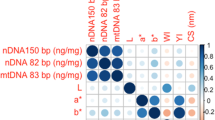Abstract
Purpose
Teeth and bones are frequently used in the genetic analysis of degraded and ancient human and animal remains. Standard extraction methods, including most commercially available systems, may not yield sufficient DNA to enable successful genetic analysis. Addition of a carrier molecule and demineralization (via EDTA) can increase yields from samples containing limited amounts of DNA. However the benefits of carrier molecules have not been demonstrated for bones and teeth and demineralization introduces large reagent volumes that are difficult to integrate into commercial DNA extraction systems.
Methods
We compared nuclear DNA yields recovered from small samples of partially decomposed human teeth using a commercial silica-based DNA extraction system with and without the addition of carrier RNA and/or a low-volume demineralization step.
Results
DNA yield was significantly improved with demineralization, but there was no significant effect of carrier RNA. The DNA content of a sample did not influence the significance of the effect of demineralization.
Conclusion
Using a simple low-volume (1 mL) demineralization step, prior to DNA extraction with the QIAmp DNA Investigator kit (Qiagen), as little as 50 mg of tooth powder can yield more than 500 ng of nuclear DNA.

Similar content being viewed by others
References
Loreille OM, Diegoli TM, Irwin JA, Coble MD, Parsons TJ. High efficiency DNA extraction from bone by total demineralization. Forensic Sci Int Genet. 2007;1:191–5.
Rohland N. DNA extraction of ancient animal hard tissue samples via adsorption to silica particles. Methods Mol Biol. 2012;840:21–8.
Kashkary L, Kemp C, Shaw KJ, Greenway GM, Haswell SJ. Improved DNA extraction efficiency from low level cell numbers using a silica monolith based micro fluidic device. Anal Chim Acta. 2012;750:127–31.
Kishore R, Hardy R, Anderson VJ, Sanchez NA, Buoncristiani MR. Optimization of DNA extraction from low-yield and degraded samples using the BioRobot EZ1 and BioRobot M48. J Forensic Sci. 2006;51:1055–61.
Gallagher ML, Burke WF, Orzech K. Carrier RNA enhancement of recovery of DNA from dilute solutions. Biochem Biophys Res Commun. 1987;144:271–6.
Shaw KJ, Thain L, Docker PT, Dyer CE, Greenman J, Greenway GM, et al. The use of carrier RNA to enhance DNA extraction from microfluidic-based silica monoliths. Anal Chim Acta. 2009;652:231–3.
Qiagen. QIAamp DNA investigator handbook. Qiagen: Hilden Germany; 2007.
Hagelberg E, Sykes B, Hedges R. Ancient bone DNA amplified. Nature. 1989;342:485.
Hochmeister MN, Budowle B, Borer UV, Eggmann U, Comey CT, Dirnhofer R. Typing of deoxyribonucleic Acid (DNA) extracted from compact bone from human remains. J Forensic Sci. 1991;36:1649–61.
Jakubowska J, Maciejewska A, Pawlowski R. Comparison of three methods of DNA extraction from human bones with different degrees of degradation. Int J Legal Med. 2012;126:173–8.
Parsons TJ, Huel R, Davoren J, Katzmarzyk C, Milos A, Selmanovic A, et al. Application of novel “mini-amplicon” STR multiplexes to high volume casework on degraded skeletal remains. Forensic Sci Int Genet. 2007;1:175–9.
Rohland N, Siedel H, Hofreiter M. A rapid column-based ancient DNA extraction method for increased sample throughput. Mol Ecol Resour. 2010;10:677–83.
Gilbert MT, Rudbeck L, Willerslev E, Hansen AJ, Smith C, Penkman KEH, et al. Biochemical and physical correlates of DNA contamination in archeological human bones and teeth excavated at Matera. Italy. J Archaeol Sci. 2005;32:785–93.
Higgins D, Austin JJ. Teeth as a source of DNA for forensic identification of human remains: a review. Sci Justice. 2013;53(4):433–41.
Swango KL, Timken MD, Chong MD, Buoncristiani MR. A quantitative PCR assay for the assessment of DNA degradation in forensic samples. Forensic Sci Int. 2006;158:14–26.
Schmittgen T. Analyzing real-time PCR data by the comparative CT method. Nat Protoc. 2008;3:1101–8.
Gaytmenn R, Sweet D. Quantification of forensic DNA from various regions of human teeth. J Forensic Sci. 2003;48:622–5.
Higgins D, Kaidonis J, Austin J, Townsend G, James H, Hughes T. Dentine and cementum as sources of nuclear DNA for use in human identification. Aust J Forensic Sci. 2011;43:287–95.
Reddy PA, Bhavanishankar M, Bhagavatula J, Harika K, Mahla RS, Shivaji S. Improved methods of carnivore faecal sample preservation, DNA extraction and quantification for accurate genotyping of wild tigers. PLoS ONE. 2012;7(10):e46732.
Author information
Authors and Affiliations
Corresponding author
Rights and permissions
About this article
Cite this article
Higgins, D., Kaidonis, J., Townsend, G. et al. Evaluation of carrier RNA and low volume demineralization for recovery of nuclear DNA from human teeth. Forensic Sci Med Pathol 10, 56–61 (2014). https://doi.org/10.1007/s12024-013-9519-2
Accepted:
Published:
Issue Date:
DOI: https://doi.org/10.1007/s12024-013-9519-2




